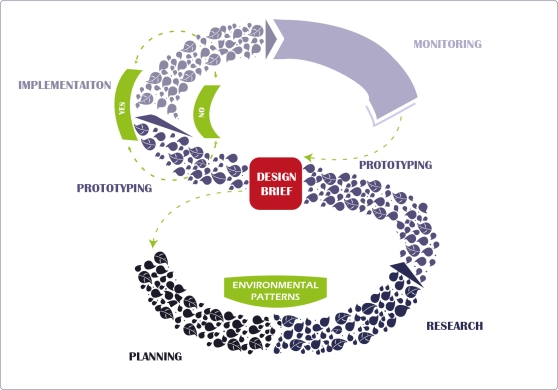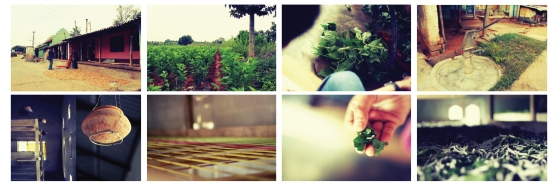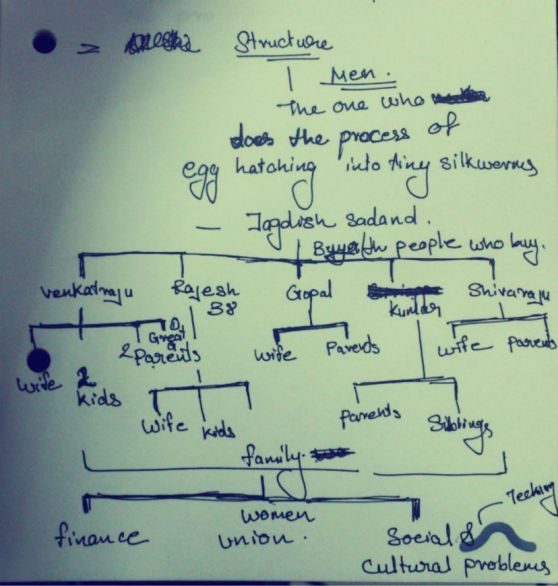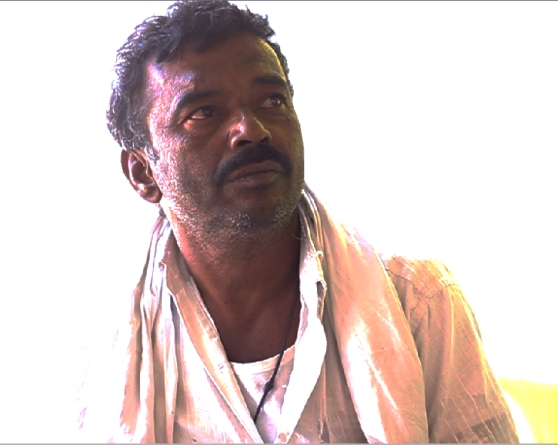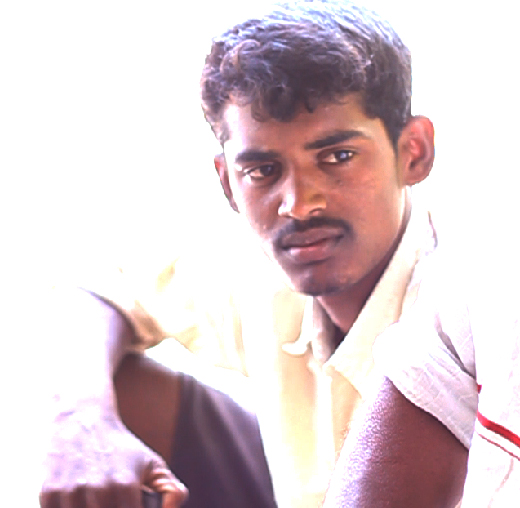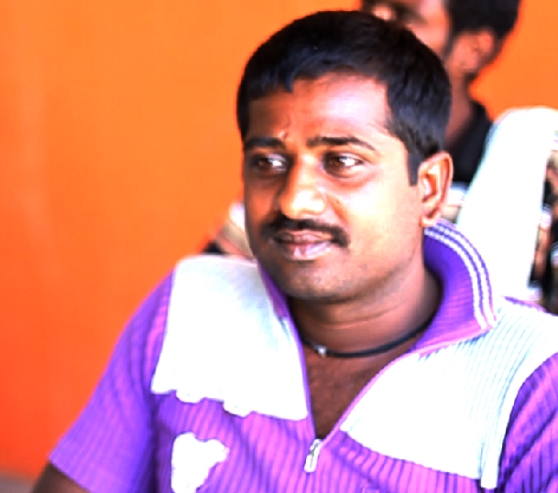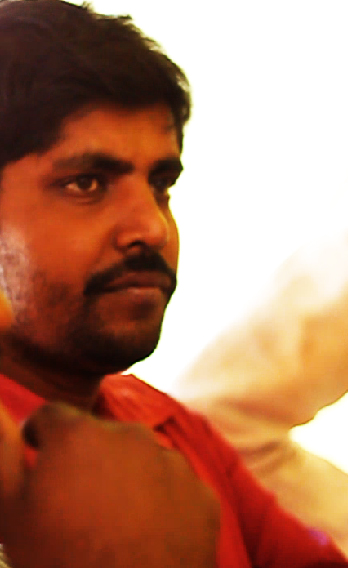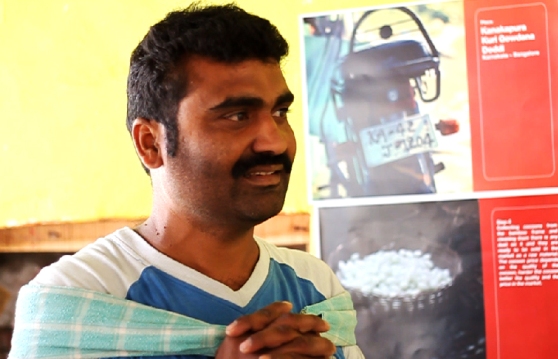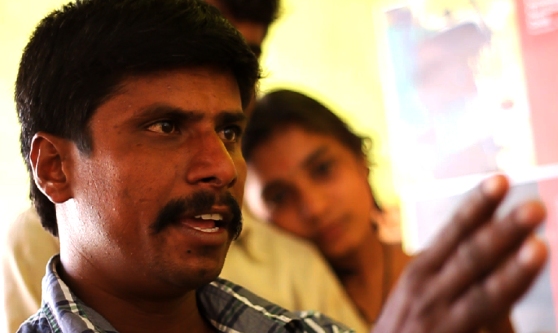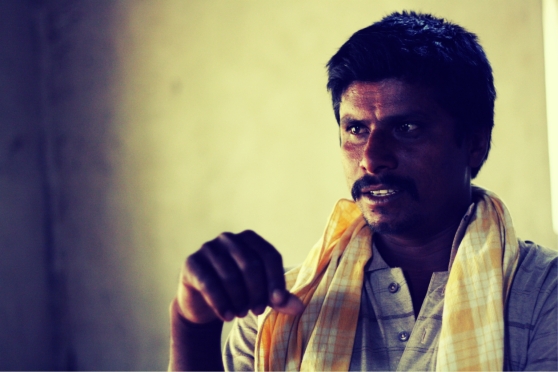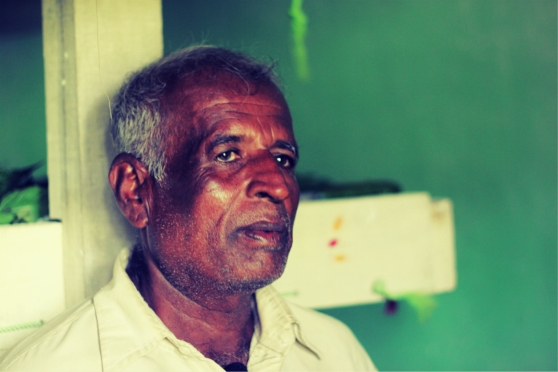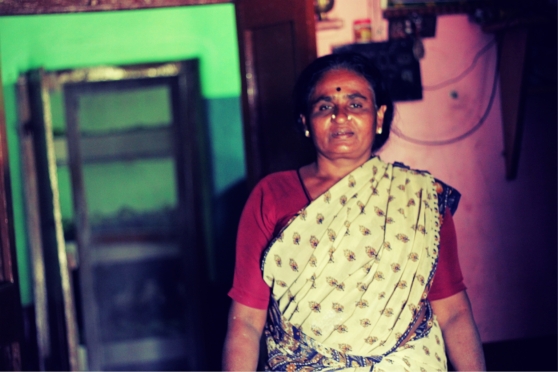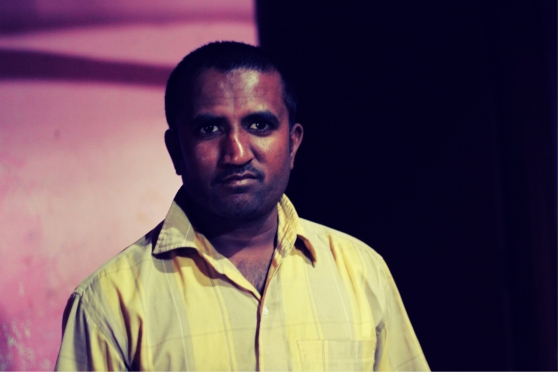Monthly Archives: January 2013
Co-Design Workshop
The workshop was conducted to extract information from the community and try to find a design pathway through the process
Results of the Workshop – III
Problems and issues
Initial plan was to have a workshop in a space where there would be availability of a wall so that it would be easier to use post its and stick the paper which we asked them to draw on
The problems are divided into, community , Occupation and general, but due to communication gap and other issues the process didn’t go as per it was planned
What happened?
Community problems
It started of with questions and me noting down what the people said with post its.
I asked them generic questions like,
are there any problems as a community ?
Do you work as a community together?
Do have any social groups which promotes social causes?
Answers- The only existing social group in the community consists of women, which is called as “nari shakti” (Women empowerment). The men in the community hasn’t been able to form a social group since there lot of issues which stops them like there different political bodies and views in India and each person follows one which creates conflict between each of the them
Occupational and General problems
The most important problems after observation and discussing with the people of the community were less water supply to the community, electricity problems and so on; all these problems connect to the occupations productivity and efficiency. Proper space for harvesting silkworms. No proper housing units which connects their occupation and living.
Occupation connects the other factors like the way of living, education, financial stability and so on.
Results of the Workshop- IV
The process break down
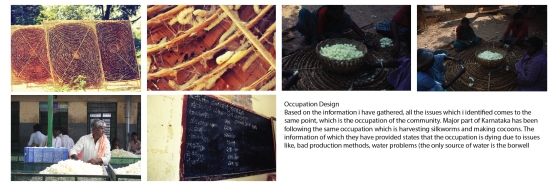 For this part of the workshop the first step was to gather people, explain them how I understand how the process of making cocoons, ask them about their opinion on the process I explained, What other techniques do they know about? and so on
For this part of the workshop the first step was to gather people, explain them how I understand how the process of making cocoons, ask them about their opinion on the process I explained, What other techniques do they know about? and so on
This method was to extract more information from the people of the community, if they had any new ideas to improve the process, if they are willing to study different methods which people outside India has practiced and has better production results then the people in India.
In response to this method there were both positive and negative outputs. The negative fact is that, the people are open to new methods but they need a practical proof to back the new ideas.
Few people even said “The occupation is dying “, all the other issues like water scarcity, electricity problems and so on which indirectly connects to their occupation.
The positive points are, the people seems to be open to the idea of learning some new ideas of making/ producing cocoons, but not just learning something new but achieving a different output from the product they make . The idea of making a learning center kind of excited the people.
Vision
How do you think your children could or would run the business further?
Answer – “It would be completely their decision to choose what they want to achieve in their near future, but there wont be any pressure to choose a field”
The fact that the community is ready and motivated to learn new methods to continue their business smoothly and yet they don’t want their children continuing or making the business more efficient.
Results of the Workshop – II
All the people introduced and got comfortable with the environment of workshop.
Community mapping –
Brief
Family structure according to the people in the community. All the other activities in the lives of the people revolves around the occupation, for example to have a better quality of living, there is need of money (where the source of income is production of cocoons from silkworms), for education there is a need for money which again connects to same aspect which is their business.
First step – Silk worms are first in the egg from which needs to be kept in a specific environment for them to hatch and silkworms to come out of the eggs. The first step of the process in this village is carried out by a man from the village called – Mr. Jagdish Sadanad from him, the silkworms of about 1/3 inch are bought by these community people (each family) and then process is carried out by the whole family.
The women in this community helps in household work as well as the business for living. Women in this community has formed an association which helps the other women when in need of finance, other general help and so on.
Results of the Workshop – I
Problems and Challenge
The biggest challenge during the work shop I faced was communication barrier, as the only language the people in the community could understand is “Kannada” (I don’t understand the language). Conveying my thought, questions and information to the people through a translator is the most difficult part of my process.
On the day of the workshop there was a political talk happening near be the village and most of the people were willing to go and not attending the workshop
The women of the community did not take part in the workshop since the inferiority complex
Workshop Results:
The workshop wasn’t a complete success, but I managed to harvest the amount of information I expected through the workshop
- Introduction –
Plan- As per the plan, each person to be given a badge (which might have made the process more interactive and fun), ask about their age and role in family/community
There were about 10 – 15 people during the first few hours and the names of some the people among the 15 are
Name: Chikkamari G
Age: 50
Role of the family: ” The older most person in the family with a wife, four kids
Name: Kumar. Chikkamari G
Age: 22
Role of the family: Son of Chikkamari and he helps his father in the production of the cocoon, which is their family business
Name: Gopal
Age: 24
Role of the family: The only son in the family and recently married. Learning to take his responsibilities
Name: Shivraju
Age: 24
Role of the family: Has been working with his father in the business from 2-3 year of cocoon (raw material) production
Name: Rajesh
Age: 35
Role of the family: The only child in the family who has been taking care of his wife, two children and his mother, he the only source of earning money in their family
Name: Venkatraju
Age: 36
Role of the family: There are about 5 people in his family excluding him, his parents and he manages the work
Phase II
Brief information about the initial research and progress it now
Co design workshop, use of this method was to know the community better and try to connect different aspects to my primary research.
In the initial research I looked at different people living in the community and the factors which connected them together, which were –
Culture- Though the community has different families clustered, they follow the same culture.
Social background There might have been changes financially in the communities families, but the social ethics like the house, way of communicating with the other community members has not changed.
Occupation – One of the aspects which connects all the issues and factors of the community’s livelihood
The biggest challenge in my research was “communication barrier” The village I have researched , that the people speak only one language which is “Kannada” where as I don’t understand their language which made my research harder.
Communicating my thoughts to a translator and conveying my message to the community people was not the way I expected it.
Workshop 2 (12-1-2013)
What do I want to achieve through the Co-design Workshop? (few general factors)
- The routine activities of their life and the problems (if any) they have been going through (social and cultural)
- Since the occupation is one of the important factor or part of their lives, does it have a proper platform according to them or could it be improved?
- A place where the practice of making cocoons could be polished
- Is there a need of a platform where the can improve upon the other expertise rather than just making the raw material (cocoon) which might enhance their business and talent.
- Other skills or talent
The plan was to set up these workshops for the people in the village
- Ice breaker – Introduction of the community members, their age and role of the person in the family and community. For example
Introduction
General questions to make them feel comfortable
What is your name?
How many people are there in your family?
How was the production of this year if compared to the last year?
What activities do men and women do differently?
More specific questions to know the future plans
What do you hope for your future? Why did you choose that to be your future?
Who do you turn to for information to get better production methods in your occupation, in or outside the community?
- Community mapping – The idea of this workshop is to know the structure of the community, to know who is the source of information for the people, who do they look up to as role model and how the people categorise their family or community members.
- Problems and issues – Dividing problems into categories like, Community problems, Occupation problems and General problems and discuss these issues with the members of the village. For example
Identify the problems
To know the different problems they have been facing by using the 5 why method. The idea is to divide the factors into –
- Community Problems
- Occupational Problems
- General Problems
(The idea is to know if there is a way to connect them and try to provide some services based on the problems)
- Process breakdown – A part talking about how they have been following one method of production of the silkworms, B part what are the problems they have been facing during each stage and C part the problems or issue, how could it be resolved. For example
Knowledge test
Write or Speak about the production methods you have been following to make cocoons.
Are you aware of any new or better production methods?
Based on the finding of the answers
Did you know?
“Case study 1 – Designboom
- Hatching silkworm eggs an ounce of silkworm eggs yields about 35,000 worms, during gestation, which lasts approximately three weeks, the eggs must stay between 25 and 31 °C, in a tray with high humidity. as they hatch, each of the tiny creatures must be carefully moved to a ‘petri dish’, a circular flat bamboo tray, to be fed with fresh mulberry leaves several times a day.
- The newly born silkworm only eats mulberry leaves. a silk farmer must have a ready supply of mulberry leaves and fruits close at hand, even one missed feeding can kill the sericulture. there are times of the year when the mulberry leaves are not around, continued food shortages can decrease the quality of silk any survivors make
- At the beginning every few days, the worms need to be moved to a clean tray with fresh food. Members of the farmer’s household must spend a growing amount of time to their bamboo trays, also because silkworms produce quite a lot of excrement and cleaning the trays is not a job for the weak-stomached. They continue feeding and moving the silkworms, dividing the colonies when the silkworms are too large or hungry for the numbers in that tray. By the fourth week, the largest of the silkworms will be more than 5 cm. long, fat, and hungry enough that they need to be fed every day.
- An easy test confirms their readiness to cocooning. The farmer picks them up and looks between their rear pair of legs, from the underside. If there is a gray mass there, the caterpillar isn’t quite ready, but if it’s milky and translucent, the silkworm has pooped its last and is definitely ready. The worms suddenly stop eating and raise their heads – another sign that they are ready for the all-important job of spinning cocoons.
- At that stage they are removed from their feeding trays. The worms are now inserted in specially woven circular bamboo scaffolding, which will make the cocoons more uniform in shape and easier to collect. Again, worms are protected from harmful flying insects by wrapping the trays with fine nets. there seems to be always a few dead silkworms in each tray. While a dramatic increase in the mortality rate is reason for concern, silkworms are insects, and farmers can expect that less than half of the silkworms will reach full maturity. each silkworm now doubles itself up on its back, and by contracting secretes, from an opening under its mouth, a steady stream of liquid silk, coated with sericin, which hardens on exposure to air. They’re starting to lay out the support strands for their cocoons, although they may not yet be serious about cocooning.
- Some of the larger caterpillars are climbing the walls of the tray (they’ve done this before, to shed their skins, but this time their heads are pointing toward the lid) and the busy silkworms are guided by figure of eight movements of their heads, to dispose the liquid silk in layers, forming the cocoon. After some 36 hours, the worms are sealed within a yellow cocoon, embarked on the process of metamorphosing into a moth.”
Important point –
– Temperature maintenance should be around 25 – 30º C (the place where the silkworms are fed)
– At the beginning every few days, the worms need to be moved to a clean tray with fresh food
– To check the readiness of the silkworms to start spinning cocoon, is when you notice milky and translucent poop.
– The , worms should be protected from harmful flying insects by wrapping the trays with fine nets
- Vision– Asking, how do they vision their children to run the community in near future? Would they continue producing the cocoons (raw material)?
Note – After every method, there would be feedback
MSP
About the process of my project phase I
Interview Day 2
Venkatraju
Venkatraju is one of the very help people who guided me throughout the process. He has been raising his family from the time he got into his teenage, now he has his parents, grandmother (she is about 110 years old), wife (who looks after the household and two kids.
This is one of the person who took me around the village showing the place where he grows the plants to feed the silkworms, the place he cultivated silkworms and the place where he get the final raw material.
He even took me to the place where the cocoon is sold and later to the buyer’s place where they make the final product which is silk thread
Interviews- Day 1
People interviewed
Bhayrappa Hoskote
About Life Style:
“I have had ups and downs in my life. I still remember we had food once in a day due to bad time in the business”
When I asked him about his way of living, he just smiled and pointed at the work he has been carrying on since 20 years now. He said all day long they have to keep looking after the silkworms; if their fed properly, if there are enough leaves for the silkworms to be fed and so on. He explained how the process of cultivating cocoons work
Mrs. Hoskote
After talking with her, came to know about their family’s culture traditions. Their family considered as a holy place, where they feed the silk warms. When we were about enter the place she asked, if I had my periods on. This gave the idea of the importance of their occupation to them.
Mahadev – son

